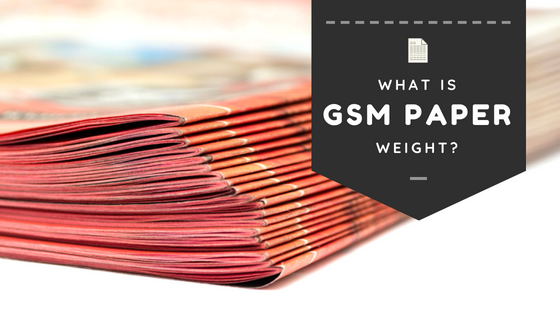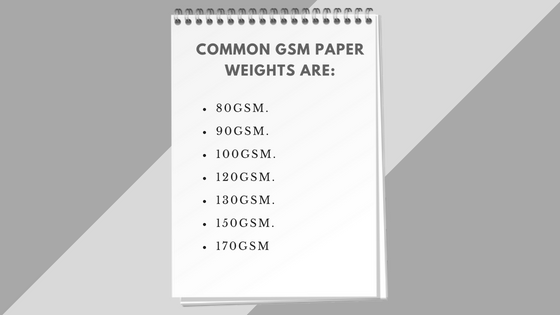You might have heard the term “GSM” if you’ve ever bought brochure covers, magazine covers, invitations, or any other printed paper product. Alternatively, perhaps you purchased a printed product in bulk and had to work out the finer points of your purchase, such as the paper weight, size and thickness. Throughout that process, you may have come upon this phrase.
If you haven’t heard of what is gsm paper, you should. Particularly, if you purchase measured printed items frequently.
Even if you’re purchasing contact information, leaflets, billboards, banners, stickers, or any other form of printed materials, this phrase can assist you more clearly define what you want.
The abbreviation ‘GSM’ stands for ‘grams per square metre.’ It is a measuring unit for paper products. GSM stands for the weight of a sheet of paper instead of the thicknesses. Simply said, the greater the GSM number, the thicker the sheet. The GSM paper weight chart ranges from thin paper to premium end patterns like a card.
The word GSM refers to the paper’s substance weight, which is defined in grammes per square metre and relates to an area of the paper that remains unchanged regardless of sheet size.
GSM will almost certainly be utilised by printers to classify the type of sheet used in the production process. As a result, if you don’t know the difference in GSM scores, you risk purchasing the incorrect paper thickness (heavier paper or lighter) for your requirements. It is an expensive error to make, especially for a small business!

It used to be a headache for a customer to choose the right sheet for his needs since there was no standardisation of sizes and weights. In general, the heavier the paper was, the denser it was. It necessitated knowledge, and several cases of poor sheet selection resulted in the project failing after printing and binding.
However, following the standardisation of paper size and weight (or paper density) in GSM or gammes per square meter, the situation altered.
When you read the word GSM used in a printing discussion, you can be sure of what is gsm paper. It refers to the thickness of the sheet being addressed. The ISO 536 standards are the most widely recognised standard for paperweights. Grammage, or the weight per sqm of the sheet, is defined by countries that use ISO 536, which relates to paper and board.

Why do books frequently use 70-90 grams/m2 Ford yellow sheet, fashionable magazine covers use 90-300g/m2 Couche paper, and marriage cards and envelopes are made of Bristol paper that weighs 230-350g/m2?
Here’s a quick guide to help you figure out which GSM to use for what:
Use a standard sheet with a GSM range of 350gsm to 400gsm if you don’t want to wind up with flimsier paper business cards.
Because flyers are small and don’t need much on them, a sheet with a weight of 250 GSM is the most common choice.
Use a sheet with a GSM of 150 to 200, although thicker papers may appear of more attractive quality and look like quite a card. When it comes to posters, it’s all about balancing the appropriate things. If you choose a thicker sheet quality, your poster may tumble down.
They generally use a 310gsm high volume art sheet for the presentation folders. The relatively high artboard is firmer than an ordinary 310gsm and provides for a robust and substantial document folder.
These should be printed on 100gsm. It’s a bit heavier material than normal and gives your company stationery a more official appearance.
Whether you’re printing bespoke packaging, business cards, flyers, or other items, the paper GSM you select will have a significant influence on how your consumers perceive your company. The GSM of your sheet has a significant impact on the overall look and feel of your printed goods.
There are many different paperweights to select from, each with its own set of characteristics that will make your items stand out. You may also send the right message to your consumers with Paper GSM. Purchasing higher GSM, such as 300 GSM, provides the idea that the company is reputable and professional.
While the bigger sheet makes a more powerful statement, it doesn’t imply you must always print your documents on it. One may commonly find thin sheets as they are more suitable, cost-effective, and useful in some situations than thick papers. As an example, consider advertising fliers.
A whole range of promotional flyers are often printed in large quantities and disseminated around the country. To assure the development of long-lasting and quality promotions, you may choose 300-gsm paper weight.
Because not all printers can support all GSMs, double-check that yours can manage the sheet GSM you intend to use. Small machines and printers will generally only handle a few GSM for in-house printing.
Furthermore, GSM is essential when putting a sheet through the press since it influences everything from imposition to ink kinds to drying periods. The printer would have a tough time digesting the sheets if your device did not handle the thickness you can use. If you are using lighter papers, the printer may potentially damage it.
Paper Size and GSM Definition:
Standards:
Types:
Paper thickness comes in a variety, with typical paper thicknesses of ordinary copy sheets range from 0.05 to 0.10 millimeters.
Notebooks and sketch pads frequently contain these sheets. They are light and easy to transport. Drawing with a pencil on a regular sheet is possible. Marker or strong ink, on the other hand, can bleed through. The most cost-effective alternatives for producing high-quality prints for companies are 90 GSM papers.
90 to 100 GSM paper is more popularly known as household printer paper in the print industry. The breadth of standard printer paper is approximately 1mm. These are the most common varieties of printer paper in homes. They are frequently sold in packs of 500 sheets of paper stocks.
Do you plan to print colour or black-and-white copies? Or do you plan to print business cards or postcards? It can help you limit down your options to the most popular paper weights for print buyers and kinds for your print project.
Consider if your print job would be better served by cardstock or non-cardstock paper. Cardstock is sometimes referred to as “cover,” “index,” and “bristol.” Text or bond papers are non-cardstock papers.
Since not all coating kinds use the same paper weight possibilities, this is a crucial step. Glossy paper, for instance, offers a 60 lb. glossy text option, but the matte paper does not. Uncoated paper comes in 50/60/70 lb. weights, but not 80/100 lb.
Allowing yourself to become engrossed with measuring paper weight is a mistake. Instead, concentrate on the type of paper you want and then select the appropriate paper weight.
Choosing the correct GSM for your printing needs is critical for producing well-designed prints that will amaze your consumers and increase your sales. There are many different types of paper thickness and paperweight range to select from, but make sure you choose the right one for your purpose.